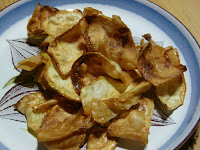 |
| Fried to golden perfection. |
One thing I determined on when we settled here on our homestead, far from the horrors and conveniences of city life, was that we'd have to get a deep fryer. Chips (fries, for American readers) are just something that I have to have from time to time and the prospect of making them from our own super tasty home-grown spuds was irresistible. Oven chips weren't going to cut it either. There's simply nothing to beat the thick cut chip, deep fried in beef dripping to pure, golden, crispy on the outside, soft and mushy on the inside perfection.
 |
| A deep fryer built for two. |
The main thing that had always put us off acquiring a deep fryer was the difficulty of dealing with the litres and litres of spent oil that would be generated as a by-product. Switching to dripping as a frying medium is a big help with this, as you can re-use it many more times than vegetable oil, which accumulates hazardous compounds with repeated use.
Dripping is also solid at room temperature, so it can easily be put out for the wild birds to enjoy, thus saving even that from going to waste. The other big fat saving was achieved by tracking down the smallest fryer we could find, which takes only one litre of fat and is the perfect size for two.
 |
| Mandolin-sliced potatoes, ready for frying. |
So, yes, the chips are fantastic and I feel more than adequately compensated for the lack of a fish & chip shop to call in at on the way home from the pub for a steaming portion of deliciousness, but now I come to the point of this post: The deep fryer is for much more than chips and potatoes. In fact, this last winter we've used it much more for making crisps (chips, for American readers). Potato crisps, to begin with, and latterly branching out into more adventurous vegetable crisps, like celeriac and Jerusalem artichoke.
 |
| Celeriac crisps |
Back in our seafaring days, we'd sat in a tiny cafe up a Galician ria, in northwestern Spain, and watched the proprietor hand-frying potato crisps for us to have as a little snack with our glasses of beer. A seed was planted. I knew it could be done. What I later discovered is that it can only be done if you have a
mandolin slicer. Now I don't know how life was possible without one.
 |
| Out of the fryer: blotting and seasoning. |
So, here's the deal:
- Scrub (and possibly peel) your vegetable of choice (potato, celeriac, Jerusalem artichoke, parsnip, beetroot, what have you).
- Thinly slice (1 mm), with your mandolin slicer (and WATCH your fingers as you get to the last bit).
- Wash, pat dry, and batch fry them at 190°C. For less starchy, more watery items like the Jerusalem artichokes, brine them overnight or for a day to draw out some of the water before drying and frying.
- Blot and season while they're still hot and prepare your taste buds for a real treat. You'll be ruined as far as store bought vegetable crisps are concerned. There's really no comparison. And you know there's no mystery ingredients, only the best of stuff.
 |
| Jerusalem artichoke crisps |
There's even a bonus item: massive cost saving! A couple of modestly sized potatoes are plenty to make a good evening snack for two. That's seriously cheap entertainment, compared with bought snacks of dubious ingredient lists.






No comments:
Post a Comment
Comments and questions are welcome.
If you've tried something after reading about it here, or have suggestions, please tell us about it!